Analyzing IKEA's HRM Practices for Employee Retention and Growth
VerifiedAdded on 2023/01/18
|26
|8380
|97
Case Study
AI Summary
This case study examines the human resource management (HRM) policies of IKEA, a global furniture retailer, and their impact on employee retention, morale, and overall company success. The report utilizes a case study research strategy, exploring IKEA's strategic HRM approach, work culture, and employee development programs. It delves into the importance of employee-centric HRM in fostering high retention rates and boosting employee performance. The methodology includes research philosophy, approach, design, and strategy, with a focus on the deductive approach and case study strategy. The study analyzes the influence of IKEA's HRM on employee satisfaction, retention, and innovation, and provides recommendations for further development. The project highlights the significance of aligning employee needs with business objectives to achieve competitive advantage in the retail sector, specifically focusing on the challenges of employee retention.
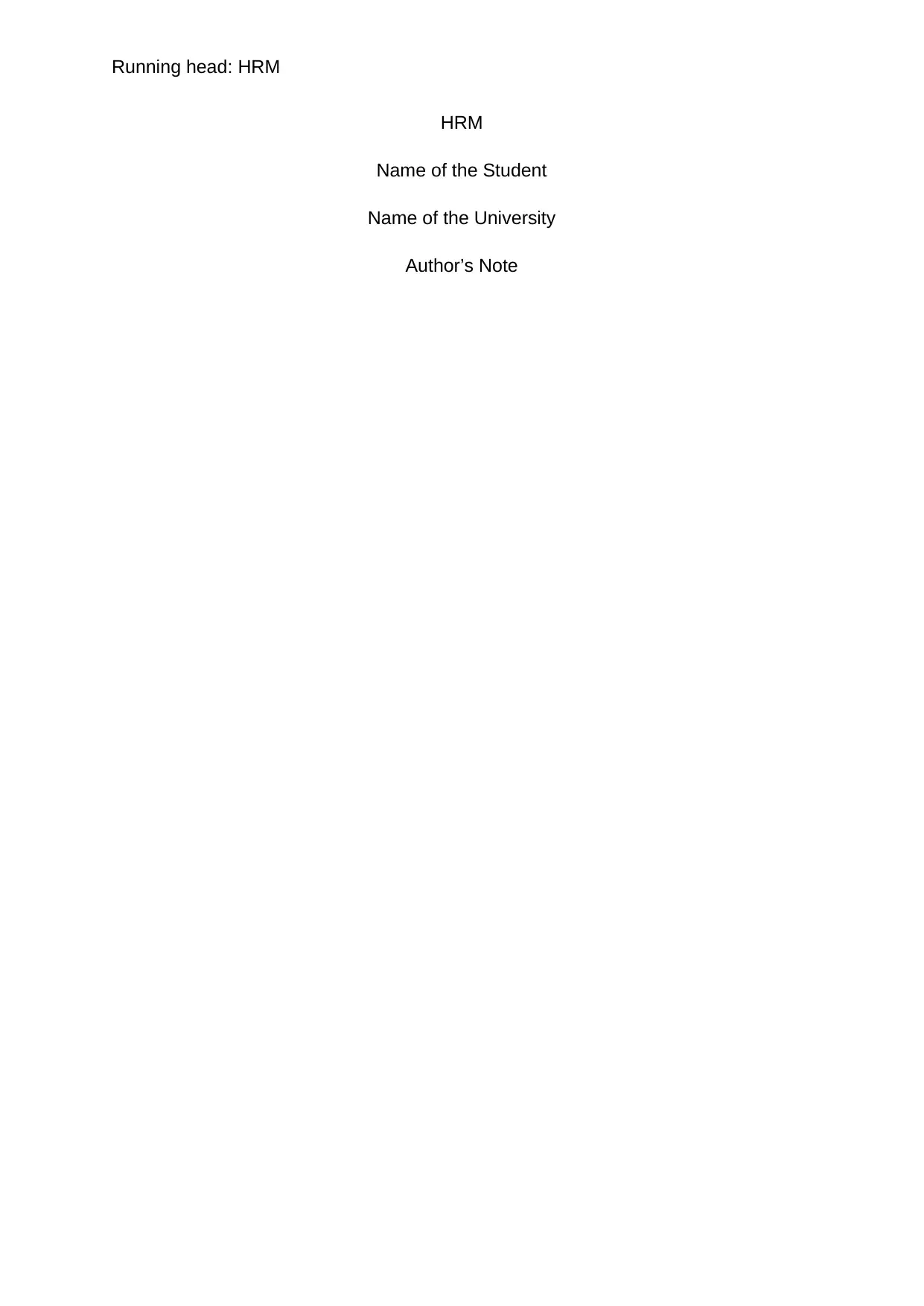
Running head: HRM
HRM
Name of the Student
Name of the University
Author’s Note
HRM
Name of the Student
Name of the University
Author’s Note
Paraphrase This Document
Need a fresh take? Get an instant paraphrase of this document with our AI Paraphraser
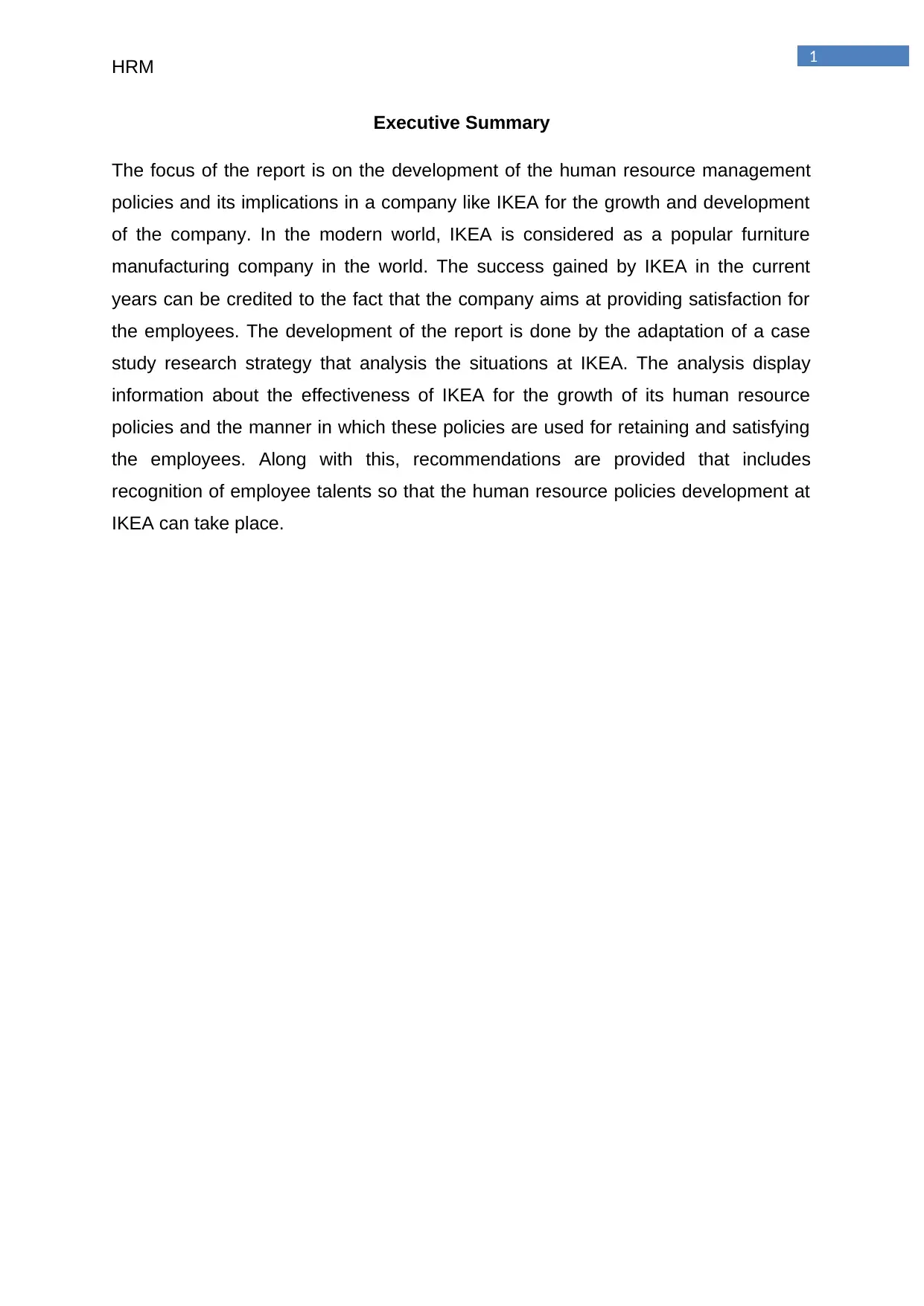
1
HRM
Executive Summary
The focus of the report is on the development of the human resource management
policies and its implications in a company like IKEA for the growth and development
of the company. In the modern world, IKEA is considered as a popular furniture
manufacturing company in the world. The success gained by IKEA in the current
years can be credited to the fact that the company aims at providing satisfaction for
the employees. The development of the report is done by the adaptation of a case
study research strategy that analysis the situations at IKEA. The analysis display
information about the effectiveness of IKEA for the growth of its human resource
policies and the manner in which these policies are used for retaining and satisfying
the employees. Along with this, recommendations are provided that includes
recognition of employee talents so that the human resource policies development at
IKEA can take place.
HRM
Executive Summary
The focus of the report is on the development of the human resource management
policies and its implications in a company like IKEA for the growth and development
of the company. In the modern world, IKEA is considered as a popular furniture
manufacturing company in the world. The success gained by IKEA in the current
years can be credited to the fact that the company aims at providing satisfaction for
the employees. The development of the report is done by the adaptation of a case
study research strategy that analysis the situations at IKEA. The analysis display
information about the effectiveness of IKEA for the growth of its human resource
policies and the manner in which these policies are used for retaining and satisfying
the employees. Along with this, recommendations are provided that includes
recognition of employee talents so that the human resource policies development at
IKEA can take place.
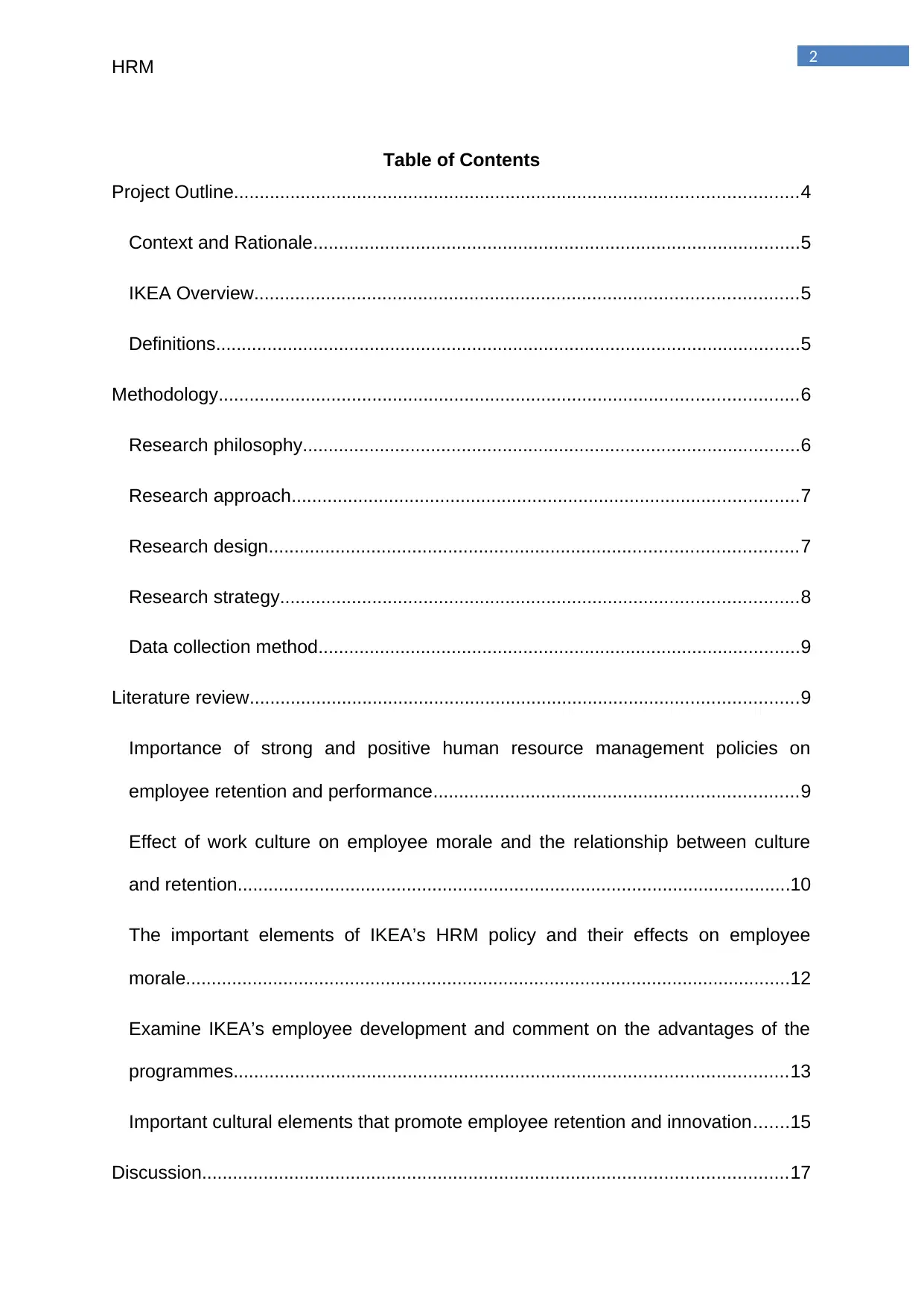
2
HRM
Table of Contents
Project Outline..............................................................................................................4
Context and Rationale...............................................................................................5
IKEA Overview..........................................................................................................5
Definitions..................................................................................................................5
Methodology.................................................................................................................6
Research philosophy.................................................................................................6
Research approach...................................................................................................7
Research design.......................................................................................................7
Research strategy.....................................................................................................8
Data collection method..............................................................................................9
Literature review...........................................................................................................9
Importance of strong and positive human resource management policies on
employee retention and performance.......................................................................9
Effect of work culture on employee morale and the relationship between culture
and retention............................................................................................................10
The important elements of IKEA’s HRM policy and their effects on employee
morale......................................................................................................................12
Examine IKEA’s employee development and comment on the advantages of the
programmes............................................................................................................13
Important cultural elements that promote employee retention and innovation.......15
Discussion..................................................................................................................17
HRM
Table of Contents
Project Outline..............................................................................................................4
Context and Rationale...............................................................................................5
IKEA Overview..........................................................................................................5
Definitions..................................................................................................................5
Methodology.................................................................................................................6
Research philosophy.................................................................................................6
Research approach...................................................................................................7
Research design.......................................................................................................7
Research strategy.....................................................................................................8
Data collection method..............................................................................................9
Literature review...........................................................................................................9
Importance of strong and positive human resource management policies on
employee retention and performance.......................................................................9
Effect of work culture on employee morale and the relationship between culture
and retention............................................................................................................10
The important elements of IKEA’s HRM policy and their effects on employee
morale......................................................................................................................12
Examine IKEA’s employee development and comment on the advantages of the
programmes............................................................................................................13
Important cultural elements that promote employee retention and innovation.......15
Discussion..................................................................................................................17
⊘ This is a preview!⊘
Do you want full access?
Subscribe today to unlock all pages.

Trusted by 1+ million students worldwide
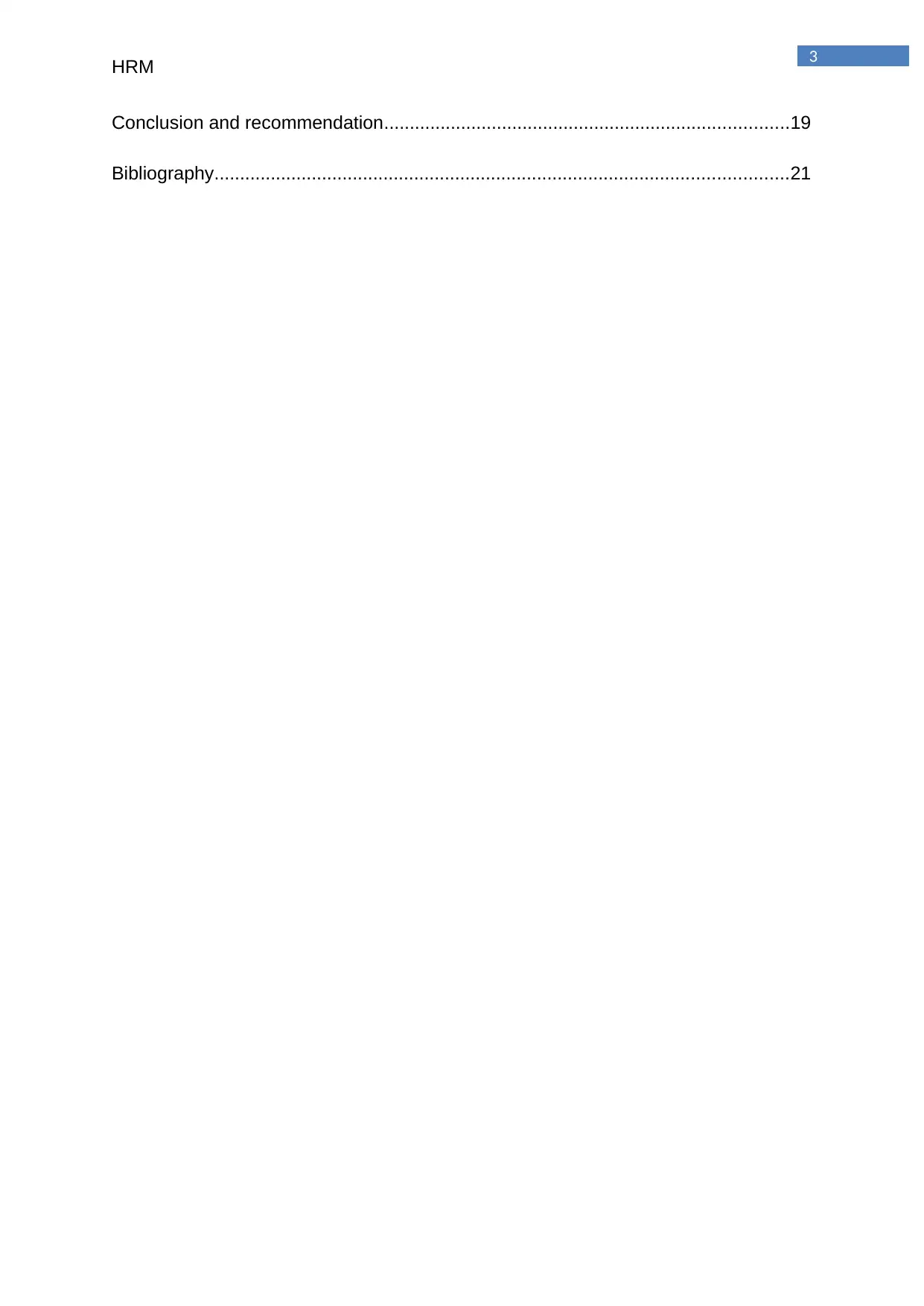
3
HRM
Conclusion and recommendation...............................................................................19
Bibliography................................................................................................................21
HRM
Conclusion and recommendation...............................................................................19
Bibliography................................................................................................................21
Paraphrase This Document
Need a fresh take? Get an instant paraphrase of this document with our AI Paraphraser
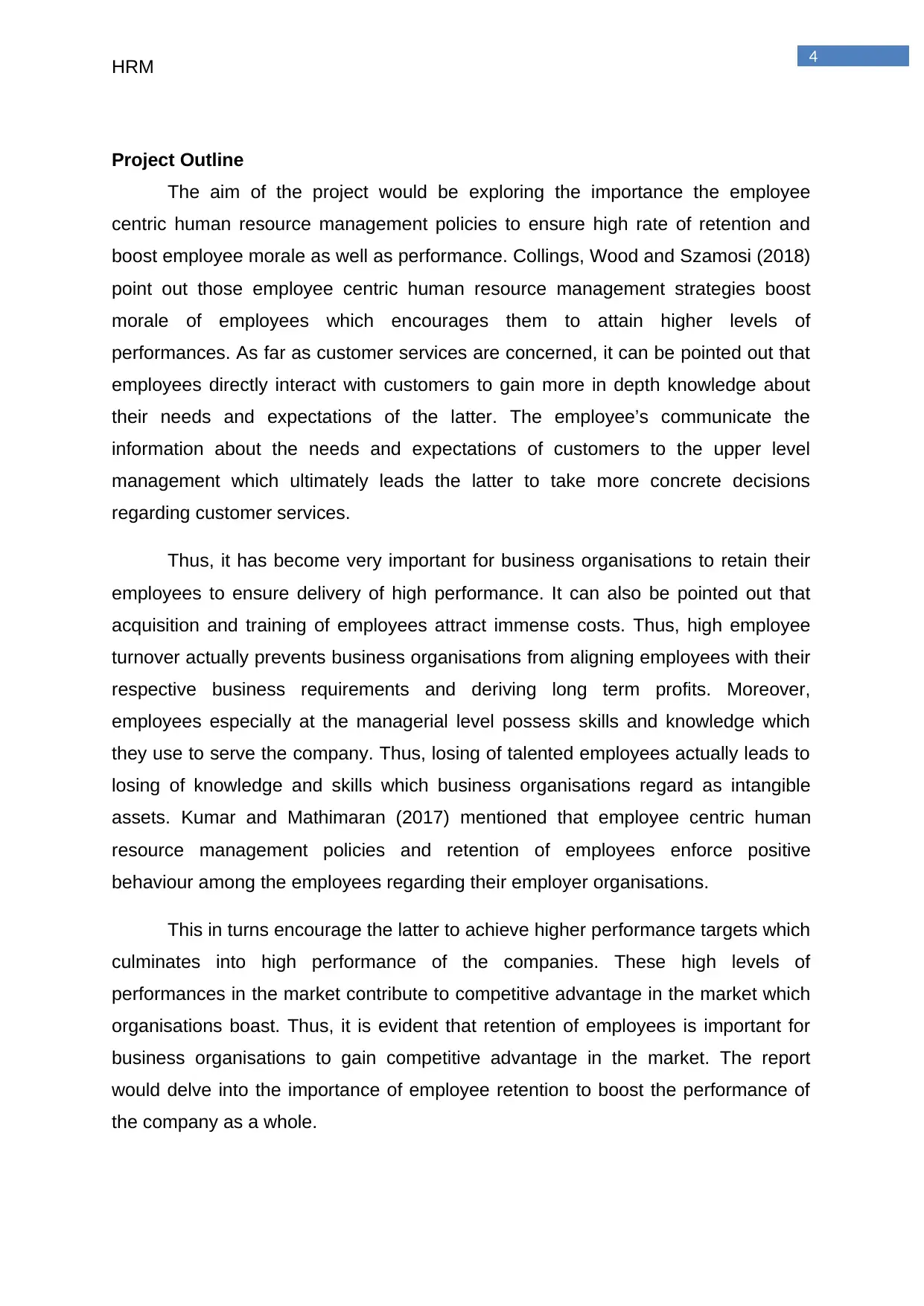
4
HRM
Project Outline
The aim of the project would be exploring the importance the employee
centric human resource management policies to ensure high rate of retention and
boost employee morale as well as performance. Collings, Wood and Szamosi (2018)
point out those employee centric human resource management strategies boost
morale of employees which encourages them to attain higher levels of
performances. As far as customer services are concerned, it can be pointed out that
employees directly interact with customers to gain more in depth knowledge about
their needs and expectations of the latter. The employee’s communicate the
information about the needs and expectations of customers to the upper level
management which ultimately leads the latter to take more concrete decisions
regarding customer services.
Thus, it has become very important for business organisations to retain their
employees to ensure delivery of high performance. It can also be pointed out that
acquisition and training of employees attract immense costs. Thus, high employee
turnover actually prevents business organisations from aligning employees with their
respective business requirements and deriving long term profits. Moreover,
employees especially at the managerial level possess skills and knowledge which
they use to serve the company. Thus, losing of talented employees actually leads to
losing of knowledge and skills which business organisations regard as intangible
assets. Kumar and Mathimaran (2017) mentioned that employee centric human
resource management policies and retention of employees enforce positive
behaviour among the employees regarding their employer organisations.
This in turns encourage the latter to achieve higher performance targets which
culminates into high performance of the companies. These high levels of
performances in the market contribute to competitive advantage in the market which
organisations boast. Thus, it is evident that retention of employees is important for
business organisations to gain competitive advantage in the market. The report
would delve into the importance of employee retention to boost the performance of
the company as a whole.
HRM
Project Outline
The aim of the project would be exploring the importance the employee
centric human resource management policies to ensure high rate of retention and
boost employee morale as well as performance. Collings, Wood and Szamosi (2018)
point out those employee centric human resource management strategies boost
morale of employees which encourages them to attain higher levels of
performances. As far as customer services are concerned, it can be pointed out that
employees directly interact with customers to gain more in depth knowledge about
their needs and expectations of the latter. The employee’s communicate the
information about the needs and expectations of customers to the upper level
management which ultimately leads the latter to take more concrete decisions
regarding customer services.
Thus, it has become very important for business organisations to retain their
employees to ensure delivery of high performance. It can also be pointed out that
acquisition and training of employees attract immense costs. Thus, high employee
turnover actually prevents business organisations from aligning employees with their
respective business requirements and deriving long term profits. Moreover,
employees especially at the managerial level possess skills and knowledge which
they use to serve the company. Thus, losing of talented employees actually leads to
losing of knowledge and skills which business organisations regard as intangible
assets. Kumar and Mathimaran (2017) mentioned that employee centric human
resource management policies and retention of employees enforce positive
behaviour among the employees regarding their employer organisations.
This in turns encourage the latter to achieve higher performance targets which
culminates into high performance of the companies. These high levels of
performances in the market contribute to competitive advantage in the market which
organisations boast. Thus, it is evident that retention of employees is important for
business organisations to gain competitive advantage in the market. The report
would delve into the importance of employee retention to boost the performance of
the company as a whole.
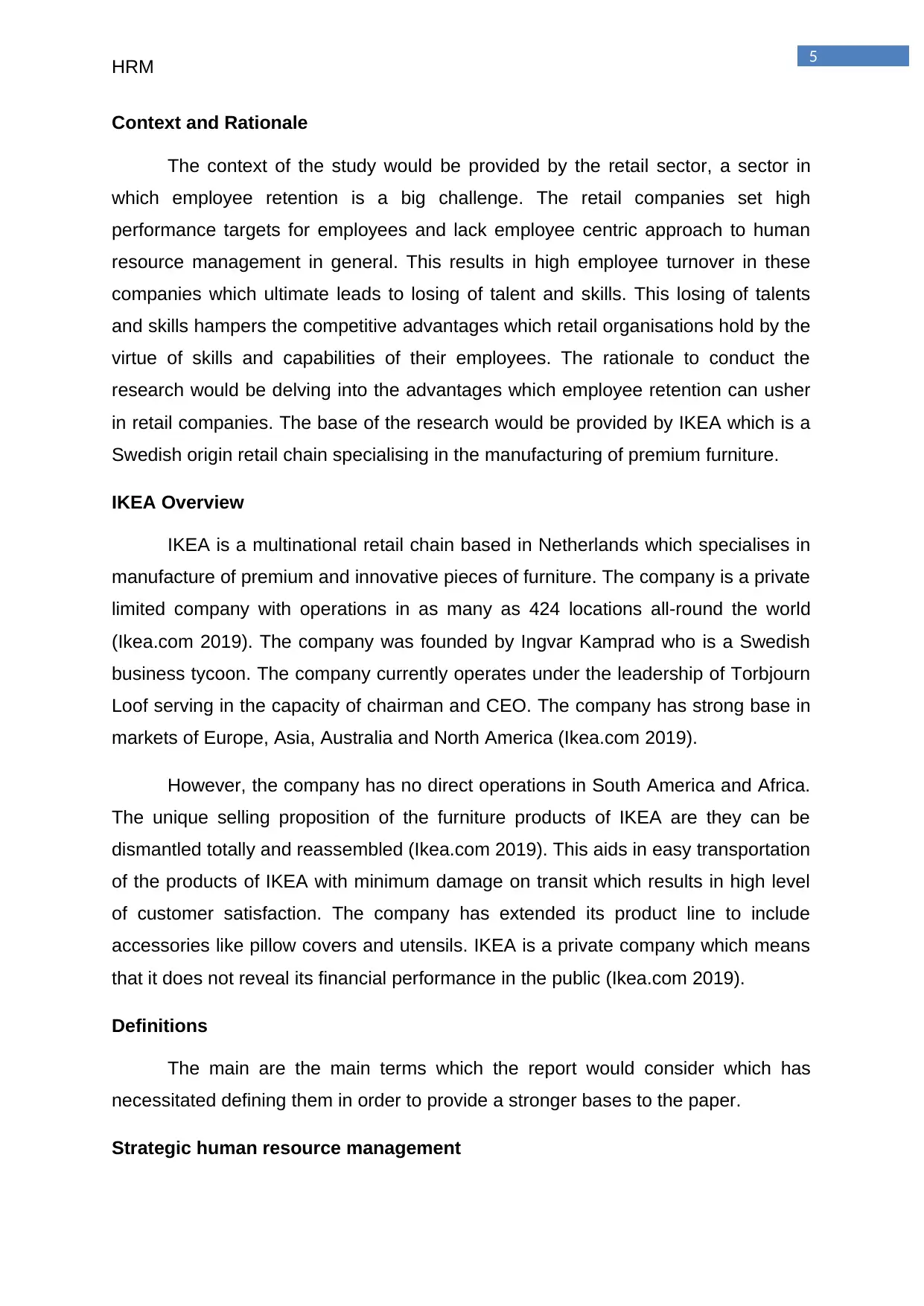
5
HRM
Context and Rationale
The context of the study would be provided by the retail sector, a sector in
which employee retention is a big challenge. The retail companies set high
performance targets for employees and lack employee centric approach to human
resource management in general. This results in high employee turnover in these
companies which ultimate leads to losing of talent and skills. This losing of talents
and skills hampers the competitive advantages which retail organisations hold by the
virtue of skills and capabilities of their employees. The rationale to conduct the
research would be delving into the advantages which employee retention can usher
in retail companies. The base of the research would be provided by IKEA which is a
Swedish origin retail chain specialising in the manufacturing of premium furniture.
IKEA Overview
IKEA is a multinational retail chain based in Netherlands which specialises in
manufacture of premium and innovative pieces of furniture. The company is a private
limited company with operations in as many as 424 locations all-round the world
(Ikea.com 2019). The company was founded by Ingvar Kamprad who is a Swedish
business tycoon. The company currently operates under the leadership of Torbjourn
Loof serving in the capacity of chairman and CEO. The company has strong base in
markets of Europe, Asia, Australia and North America (Ikea.com 2019).
However, the company has no direct operations in South America and Africa.
The unique selling proposition of the furniture products of IKEA are they can be
dismantled totally and reassembled (Ikea.com 2019). This aids in easy transportation
of the products of IKEA with minimum damage on transit which results in high level
of customer satisfaction. The company has extended its product line to include
accessories like pillow covers and utensils. IKEA is a private company which means
that it does not reveal its financial performance in the public (Ikea.com 2019).
Definitions
The main are the main terms which the report would consider which has
necessitated defining them in order to provide a stronger bases to the paper.
Strategic human resource management
HRM
Context and Rationale
The context of the study would be provided by the retail sector, a sector in
which employee retention is a big challenge. The retail companies set high
performance targets for employees and lack employee centric approach to human
resource management in general. This results in high employee turnover in these
companies which ultimate leads to losing of talent and skills. This losing of talents
and skills hampers the competitive advantages which retail organisations hold by the
virtue of skills and capabilities of their employees. The rationale to conduct the
research would be delving into the advantages which employee retention can usher
in retail companies. The base of the research would be provided by IKEA which is a
Swedish origin retail chain specialising in the manufacturing of premium furniture.
IKEA Overview
IKEA is a multinational retail chain based in Netherlands which specialises in
manufacture of premium and innovative pieces of furniture. The company is a private
limited company with operations in as many as 424 locations all-round the world
(Ikea.com 2019). The company was founded by Ingvar Kamprad who is a Swedish
business tycoon. The company currently operates under the leadership of Torbjourn
Loof serving in the capacity of chairman and CEO. The company has strong base in
markets of Europe, Asia, Australia and North America (Ikea.com 2019).
However, the company has no direct operations in South America and Africa.
The unique selling proposition of the furniture products of IKEA are they can be
dismantled totally and reassembled (Ikea.com 2019). This aids in easy transportation
of the products of IKEA with minimum damage on transit which results in high level
of customer satisfaction. The company has extended its product line to include
accessories like pillow covers and utensils. IKEA is a private company which means
that it does not reveal its financial performance in the public (Ikea.com 2019).
Definitions
The main are the main terms which the report would consider which has
necessitated defining them in order to provide a stronger bases to the paper.
Strategic human resource management
⊘ This is a preview!⊘
Do you want full access?
Subscribe today to unlock all pages.

Trusted by 1+ million students worldwide
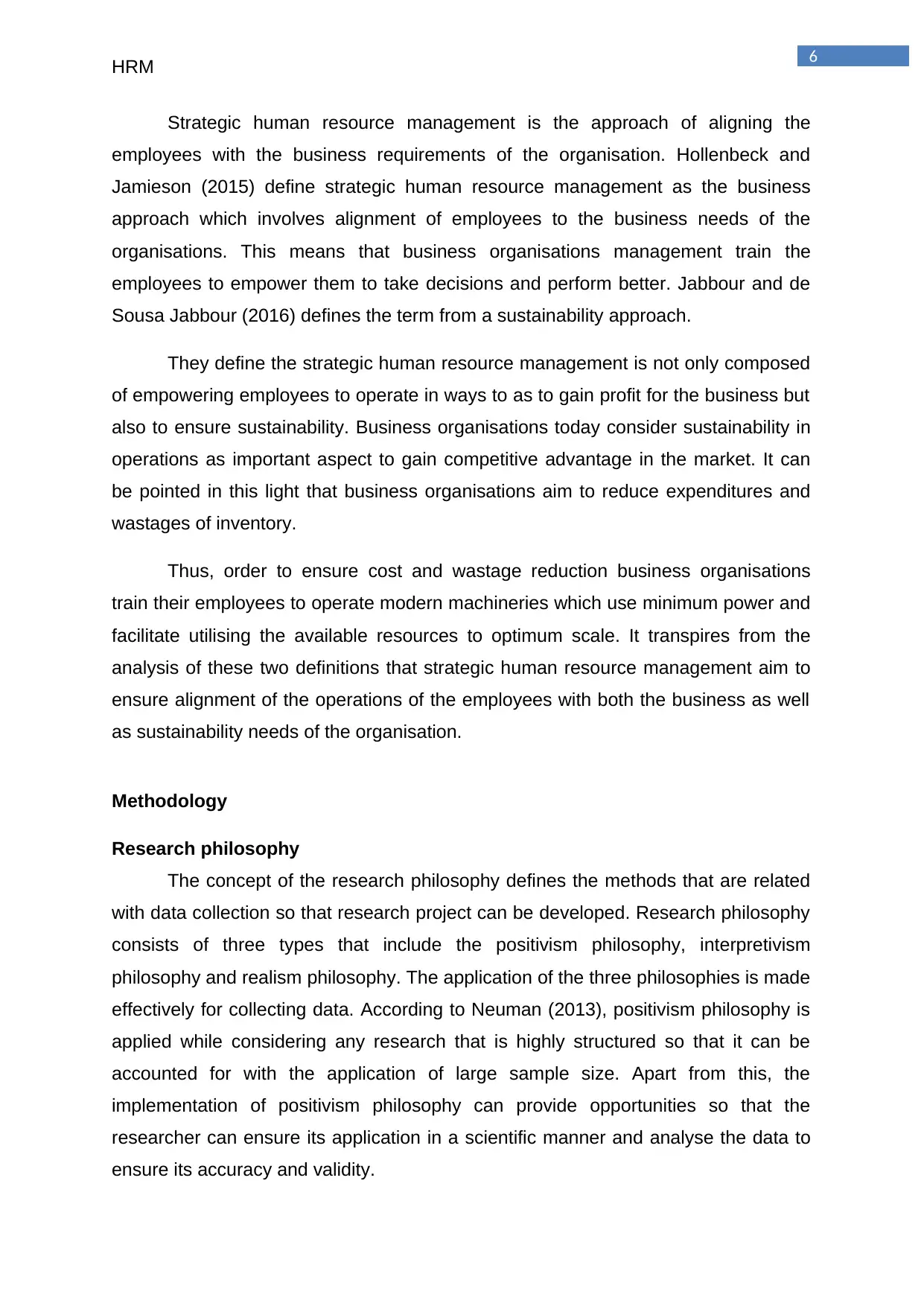
6
HRM
Strategic human resource management is the approach of aligning the
employees with the business requirements of the organisation. Hollenbeck and
Jamieson (2015) define strategic human resource management as the business
approach which involves alignment of employees to the business needs of the
organisations. This means that business organisations management train the
employees to empower them to take decisions and perform better. Jabbour and de
Sousa Jabbour (2016) defines the term from a sustainability approach.
They define the strategic human resource management is not only composed
of empowering employees to operate in ways to as to gain profit for the business but
also to ensure sustainability. Business organisations today consider sustainability in
operations as important aspect to gain competitive advantage in the market. It can
be pointed in this light that business organisations aim to reduce expenditures and
wastages of inventory.
Thus, order to ensure cost and wastage reduction business organisations
train their employees to operate modern machineries which use minimum power and
facilitate utilising the available resources to optimum scale. It transpires from the
analysis of these two definitions that strategic human resource management aim to
ensure alignment of the operations of the employees with both the business as well
as sustainability needs of the organisation.
Methodology
Research philosophy
The concept of the research philosophy defines the methods that are related
with data collection so that research project can be developed. Research philosophy
consists of three types that include the positivism philosophy, interpretivism
philosophy and realism philosophy. The application of the three philosophies is made
effectively for collecting data. According to Neuman (2013), positivism philosophy is
applied while considering any research that is highly structured so that it can be
accounted for with the application of large sample size. Apart from this, the
implementation of positivism philosophy can provide opportunities so that the
researcher can ensure its application in a scientific manner and analyse the data to
ensure its accuracy and validity.
HRM
Strategic human resource management is the approach of aligning the
employees with the business requirements of the organisation. Hollenbeck and
Jamieson (2015) define strategic human resource management as the business
approach which involves alignment of employees to the business needs of the
organisations. This means that business organisations management train the
employees to empower them to take decisions and perform better. Jabbour and de
Sousa Jabbour (2016) defines the term from a sustainability approach.
They define the strategic human resource management is not only composed
of empowering employees to operate in ways to as to gain profit for the business but
also to ensure sustainability. Business organisations today consider sustainability in
operations as important aspect to gain competitive advantage in the market. It can
be pointed in this light that business organisations aim to reduce expenditures and
wastages of inventory.
Thus, order to ensure cost and wastage reduction business organisations
train their employees to operate modern machineries which use minimum power and
facilitate utilising the available resources to optimum scale. It transpires from the
analysis of these two definitions that strategic human resource management aim to
ensure alignment of the operations of the employees with both the business as well
as sustainability needs of the organisation.
Methodology
Research philosophy
The concept of the research philosophy defines the methods that are related
with data collection so that research project can be developed. Research philosophy
consists of three types that include the positivism philosophy, interpretivism
philosophy and realism philosophy. The application of the three philosophies is made
effectively for collecting data. According to Neuman (2013), positivism philosophy is
applied while considering any research that is highly structured so that it can be
accounted for with the application of large sample size. Apart from this, the
implementation of positivism philosophy can provide opportunities so that the
researcher can ensure its application in a scientific manner and analyse the data to
ensure its accuracy and validity.
Paraphrase This Document
Need a fresh take? Get an instant paraphrase of this document with our AI Paraphraser
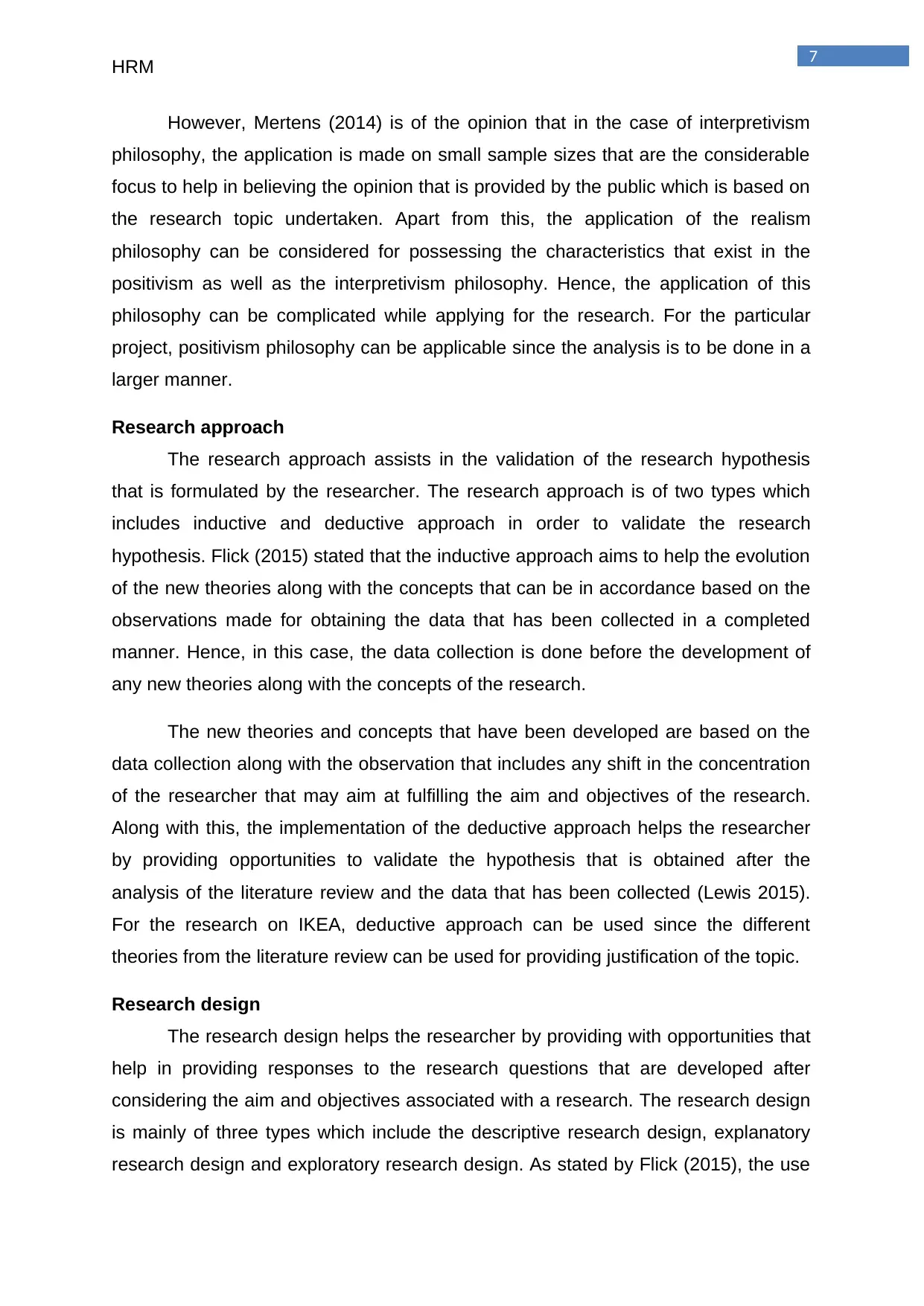
7
HRM
However, Mertens (2014) is of the opinion that in the case of interpretivism
philosophy, the application is made on small sample sizes that are the considerable
focus to help in believing the opinion that is provided by the public which is based on
the research topic undertaken. Apart from this, the application of the realism
philosophy can be considered for possessing the characteristics that exist in the
positivism as well as the interpretivism philosophy. Hence, the application of this
philosophy can be complicated while applying for the research. For the particular
project, positivism philosophy can be applicable since the analysis is to be done in a
larger manner.
Research approach
The research approach assists in the validation of the research hypothesis
that is formulated by the researcher. The research approach is of two types which
includes inductive and deductive approach in order to validate the research
hypothesis. Flick (2015) stated that the inductive approach aims to help the evolution
of the new theories along with the concepts that can be in accordance based on the
observations made for obtaining the data that has been collected in a completed
manner. Hence, in this case, the data collection is done before the development of
any new theories along with the concepts of the research.
The new theories and concepts that have been developed are based on the
data collection along with the observation that includes any shift in the concentration
of the researcher that may aim at fulfilling the aim and objectives of the research.
Along with this, the implementation of the deductive approach helps the researcher
by providing opportunities to validate the hypothesis that is obtained after the
analysis of the literature review and the data that has been collected (Lewis 2015).
For the research on IKEA, deductive approach can be used since the different
theories from the literature review can be used for providing justification of the topic.
Research design
The research design helps the researcher by providing with opportunities that
help in providing responses to the research questions that are developed after
considering the aim and objectives associated with a research. The research design
is mainly of three types which include the descriptive research design, explanatory
research design and exploratory research design. As stated by Flick (2015), the use
HRM
However, Mertens (2014) is of the opinion that in the case of interpretivism
philosophy, the application is made on small sample sizes that are the considerable
focus to help in believing the opinion that is provided by the public which is based on
the research topic undertaken. Apart from this, the application of the realism
philosophy can be considered for possessing the characteristics that exist in the
positivism as well as the interpretivism philosophy. Hence, the application of this
philosophy can be complicated while applying for the research. For the particular
project, positivism philosophy can be applicable since the analysis is to be done in a
larger manner.
Research approach
The research approach assists in the validation of the research hypothesis
that is formulated by the researcher. The research approach is of two types which
includes inductive and deductive approach in order to validate the research
hypothesis. Flick (2015) stated that the inductive approach aims to help the evolution
of the new theories along with the concepts that can be in accordance based on the
observations made for obtaining the data that has been collected in a completed
manner. Hence, in this case, the data collection is done before the development of
any new theories along with the concepts of the research.
The new theories and concepts that have been developed are based on the
data collection along with the observation that includes any shift in the concentration
of the researcher that may aim at fulfilling the aim and objectives of the research.
Along with this, the implementation of the deductive approach helps the researcher
by providing opportunities to validate the hypothesis that is obtained after the
analysis of the literature review and the data that has been collected (Lewis 2015).
For the research on IKEA, deductive approach can be used since the different
theories from the literature review can be used for providing justification of the topic.
Research design
The research design helps the researcher by providing with opportunities that
help in providing responses to the research questions that are developed after
considering the aim and objectives associated with a research. The research design
is mainly of three types which include the descriptive research design, explanatory
research design and exploratory research design. As stated by Flick (2015), the use
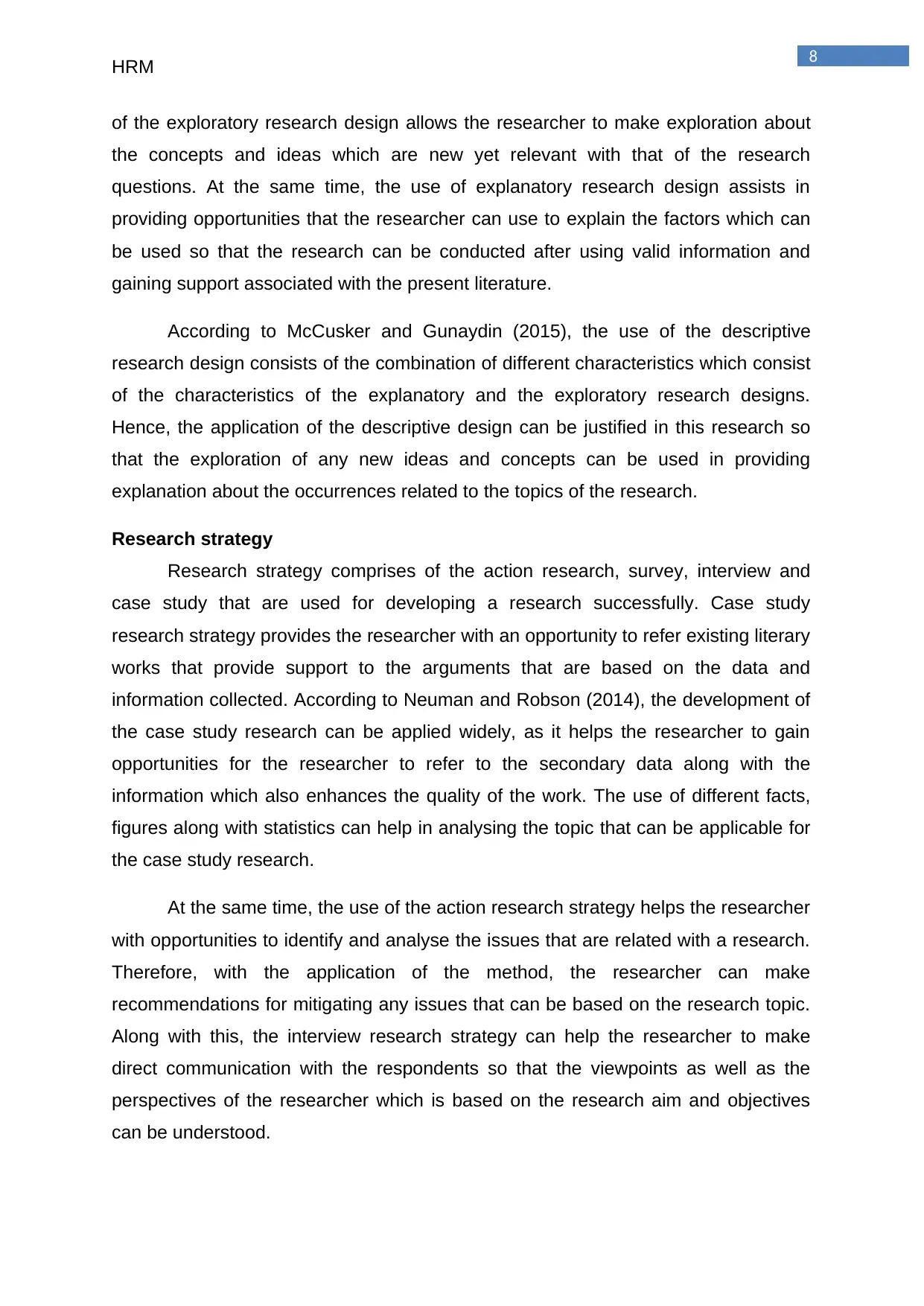
8
HRM
of the exploratory research design allows the researcher to make exploration about
the concepts and ideas which are new yet relevant with that of the research
questions. At the same time, the use of explanatory research design assists in
providing opportunities that the researcher can use to explain the factors which can
be used so that the research can be conducted after using valid information and
gaining support associated with the present literature.
According to McCusker and Gunaydin (2015), the use of the descriptive
research design consists of the combination of different characteristics which consist
of the characteristics of the explanatory and the exploratory research designs.
Hence, the application of the descriptive design can be justified in this research so
that the exploration of any new ideas and concepts can be used in providing
explanation about the occurrences related to the topics of the research.
Research strategy
Research strategy comprises of the action research, survey, interview and
case study that are used for developing a research successfully. Case study
research strategy provides the researcher with an opportunity to refer existing literary
works that provide support to the arguments that are based on the data and
information collected. According to Neuman and Robson (2014), the development of
the case study research can be applied widely, as it helps the researcher to gain
opportunities for the researcher to refer to the secondary data along with the
information which also enhances the quality of the work. The use of different facts,
figures along with statistics can help in analysing the topic that can be applicable for
the case study research.
At the same time, the use of the action research strategy helps the researcher
with opportunities to identify and analyse the issues that are related with a research.
Therefore, with the application of the method, the researcher can make
recommendations for mitigating any issues that can be based on the research topic.
Along with this, the interview research strategy can help the researcher to make
direct communication with the respondents so that the viewpoints as well as the
perspectives of the researcher which is based on the research aim and objectives
can be understood.
HRM
of the exploratory research design allows the researcher to make exploration about
the concepts and ideas which are new yet relevant with that of the research
questions. At the same time, the use of explanatory research design assists in
providing opportunities that the researcher can use to explain the factors which can
be used so that the research can be conducted after using valid information and
gaining support associated with the present literature.
According to McCusker and Gunaydin (2015), the use of the descriptive
research design consists of the combination of different characteristics which consist
of the characteristics of the explanatory and the exploratory research designs.
Hence, the application of the descriptive design can be justified in this research so
that the exploration of any new ideas and concepts can be used in providing
explanation about the occurrences related to the topics of the research.
Research strategy
Research strategy comprises of the action research, survey, interview and
case study that are used for developing a research successfully. Case study
research strategy provides the researcher with an opportunity to refer existing literary
works that provide support to the arguments that are based on the data and
information collected. According to Neuman and Robson (2014), the development of
the case study research can be applied widely, as it helps the researcher to gain
opportunities for the researcher to refer to the secondary data along with the
information which also enhances the quality of the work. The use of different facts,
figures along with statistics can help in analysing the topic that can be applicable for
the case study research.
At the same time, the use of the action research strategy helps the researcher
with opportunities to identify and analyse the issues that are related with a research.
Therefore, with the application of the method, the researcher can make
recommendations for mitigating any issues that can be based on the research topic.
Along with this, the interview research strategy can help the researcher to make
direct communication with the respondents so that the viewpoints as well as the
perspectives of the researcher which is based on the research aim and objectives
can be understood.
⊘ This is a preview!⊘
Do you want full access?
Subscribe today to unlock all pages.

Trusted by 1+ million students worldwide
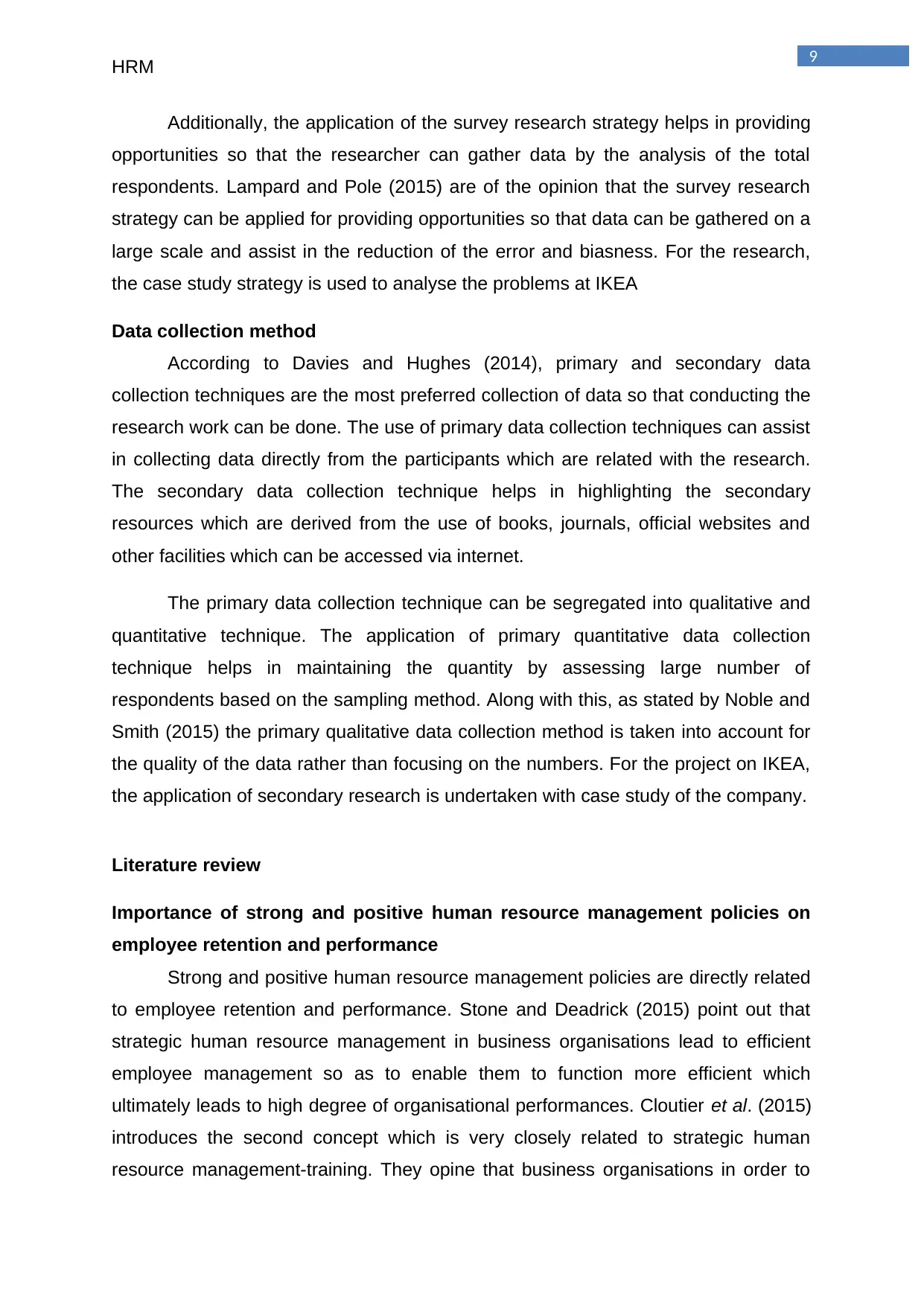
9
HRM
Additionally, the application of the survey research strategy helps in providing
opportunities so that the researcher can gather data by the analysis of the total
respondents. Lampard and Pole (2015) are of the opinion that the survey research
strategy can be applied for providing opportunities so that data can be gathered on a
large scale and assist in the reduction of the error and biasness. For the research,
the case study strategy is used to analyse the problems at IKEA
Data collection method
According to Davies and Hughes (2014), primary and secondary data
collection techniques are the most preferred collection of data so that conducting the
research work can be done. The use of primary data collection techniques can assist
in collecting data directly from the participants which are related with the research.
The secondary data collection technique helps in highlighting the secondary
resources which are derived from the use of books, journals, official websites and
other facilities which can be accessed via internet.
The primary data collection technique can be segregated into qualitative and
quantitative technique. The application of primary quantitative data collection
technique helps in maintaining the quantity by assessing large number of
respondents based on the sampling method. Along with this, as stated by Noble and
Smith (2015) the primary qualitative data collection method is taken into account for
the quality of the data rather than focusing on the numbers. For the project on IKEA,
the application of secondary research is undertaken with case study of the company.
Literature review
Importance of strong and positive human resource management policies on
employee retention and performance
Strong and positive human resource management policies are directly related
to employee retention and performance. Stone and Deadrick (2015) point out that
strategic human resource management in business organisations lead to efficient
employee management so as to enable them to function more efficient which
ultimately leads to high degree of organisational performances. Cloutier et al. (2015)
introduces the second concept which is very closely related to strategic human
resource management-training. They opine that business organisations in order to
HRM
Additionally, the application of the survey research strategy helps in providing
opportunities so that the researcher can gather data by the analysis of the total
respondents. Lampard and Pole (2015) are of the opinion that the survey research
strategy can be applied for providing opportunities so that data can be gathered on a
large scale and assist in the reduction of the error and biasness. For the research,
the case study strategy is used to analyse the problems at IKEA
Data collection method
According to Davies and Hughes (2014), primary and secondary data
collection techniques are the most preferred collection of data so that conducting the
research work can be done. The use of primary data collection techniques can assist
in collecting data directly from the participants which are related with the research.
The secondary data collection technique helps in highlighting the secondary
resources which are derived from the use of books, journals, official websites and
other facilities which can be accessed via internet.
The primary data collection technique can be segregated into qualitative and
quantitative technique. The application of primary quantitative data collection
technique helps in maintaining the quantity by assessing large number of
respondents based on the sampling method. Along with this, as stated by Noble and
Smith (2015) the primary qualitative data collection method is taken into account for
the quality of the data rather than focusing on the numbers. For the project on IKEA,
the application of secondary research is undertaken with case study of the company.
Literature review
Importance of strong and positive human resource management policies on
employee retention and performance
Strong and positive human resource management policies are directly related
to employee retention and performance. Stone and Deadrick (2015) point out that
strategic human resource management in business organisations lead to efficient
employee management so as to enable them to function more efficient which
ultimately leads to high degree of organisational performances. Cloutier et al. (2015)
introduces the second concept which is very closely related to strategic human
resource management-training. They opine that business organisations in order to
Paraphrase This Document
Need a fresh take? Get an instant paraphrase of this document with our AI Paraphraser
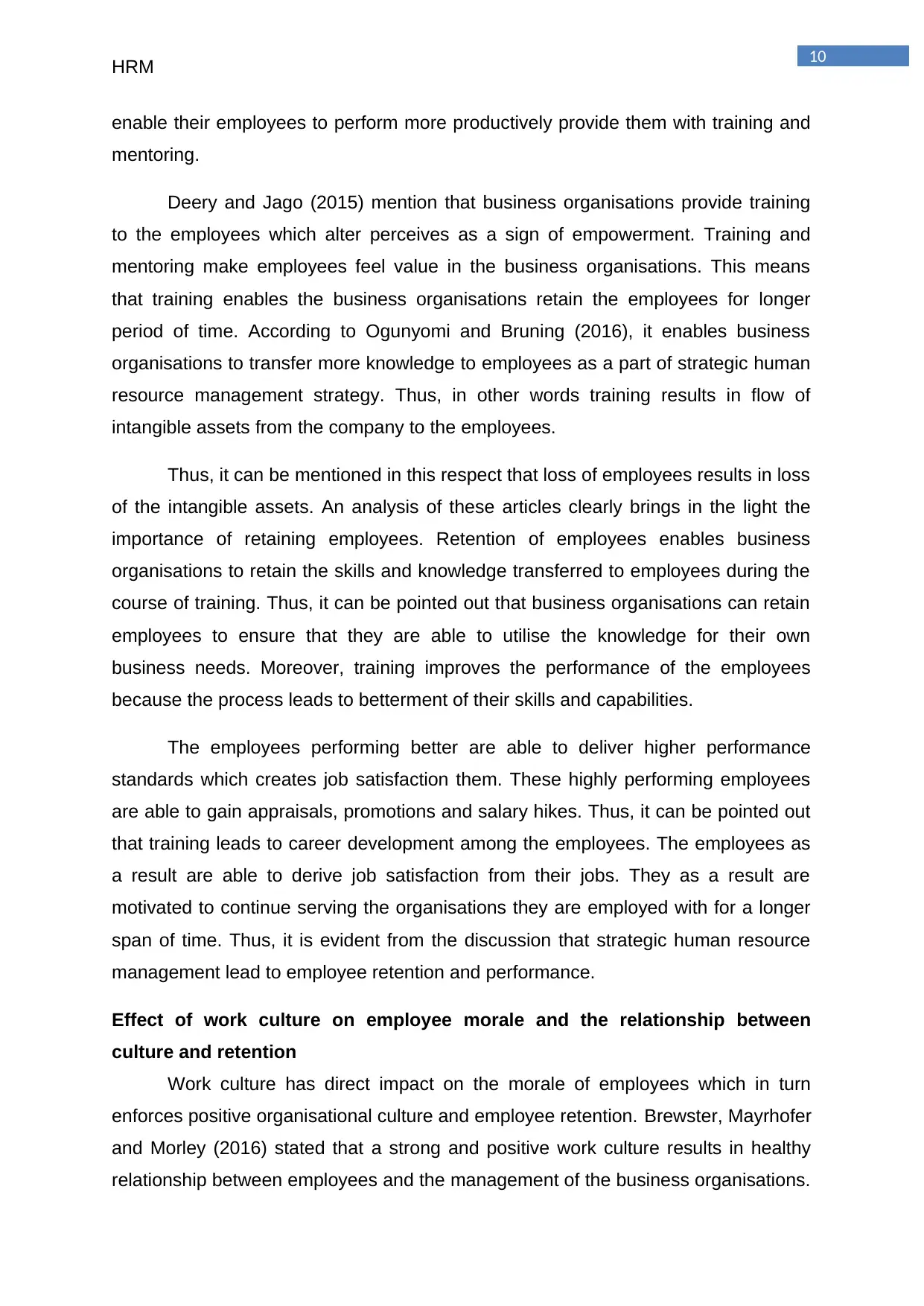
10
HRM
enable their employees to perform more productively provide them with training and
mentoring.
Deery and Jago (2015) mention that business organisations provide training
to the employees which alter perceives as a sign of empowerment. Training and
mentoring make employees feel value in the business organisations. This means
that training enables the business organisations retain the employees for longer
period of time. According to Ogunyomi and Bruning (2016), it enables business
organisations to transfer more knowledge to employees as a part of strategic human
resource management strategy. Thus, in other words training results in flow of
intangible assets from the company to the employees.
Thus, it can be mentioned in this respect that loss of employees results in loss
of the intangible assets. An analysis of these articles clearly brings in the light the
importance of retaining employees. Retention of employees enables business
organisations to retain the skills and knowledge transferred to employees during the
course of training. Thus, it can be pointed out that business organisations can retain
employees to ensure that they are able to utilise the knowledge for their own
business needs. Moreover, training improves the performance of the employees
because the process leads to betterment of their skills and capabilities.
The employees performing better are able to deliver higher performance
standards which creates job satisfaction them. These highly performing employees
are able to gain appraisals, promotions and salary hikes. Thus, it can be pointed out
that training leads to career development among the employees. The employees as
a result are able to derive job satisfaction from their jobs. They as a result are
motivated to continue serving the organisations they are employed with for a longer
span of time. Thus, it is evident from the discussion that strategic human resource
management lead to employee retention and performance.
Effect of work culture on employee morale and the relationship between
culture and retention
Work culture has direct impact on the morale of employees which in turn
enforces positive organisational culture and employee retention. Brewster, Mayrhofer
and Morley (2016) stated that a strong and positive work culture results in healthy
relationship between employees and the management of the business organisations.
HRM
enable their employees to perform more productively provide them with training and
mentoring.
Deery and Jago (2015) mention that business organisations provide training
to the employees which alter perceives as a sign of empowerment. Training and
mentoring make employees feel value in the business organisations. This means
that training enables the business organisations retain the employees for longer
period of time. According to Ogunyomi and Bruning (2016), it enables business
organisations to transfer more knowledge to employees as a part of strategic human
resource management strategy. Thus, in other words training results in flow of
intangible assets from the company to the employees.
Thus, it can be mentioned in this respect that loss of employees results in loss
of the intangible assets. An analysis of these articles clearly brings in the light the
importance of retaining employees. Retention of employees enables business
organisations to retain the skills and knowledge transferred to employees during the
course of training. Thus, it can be pointed out that business organisations can retain
employees to ensure that they are able to utilise the knowledge for their own
business needs. Moreover, training improves the performance of the employees
because the process leads to betterment of their skills and capabilities.
The employees performing better are able to deliver higher performance
standards which creates job satisfaction them. These highly performing employees
are able to gain appraisals, promotions and salary hikes. Thus, it can be pointed out
that training leads to career development among the employees. The employees as
a result are able to derive job satisfaction from their jobs. They as a result are
motivated to continue serving the organisations they are employed with for a longer
span of time. Thus, it is evident from the discussion that strategic human resource
management lead to employee retention and performance.
Effect of work culture on employee morale and the relationship between
culture and retention
Work culture has direct impact on the morale of employees which in turn
enforces positive organisational culture and employee retention. Brewster, Mayrhofer
and Morley (2016) stated that a strong and positive work culture results in healthy
relationship between employees and the management of the business organisations.
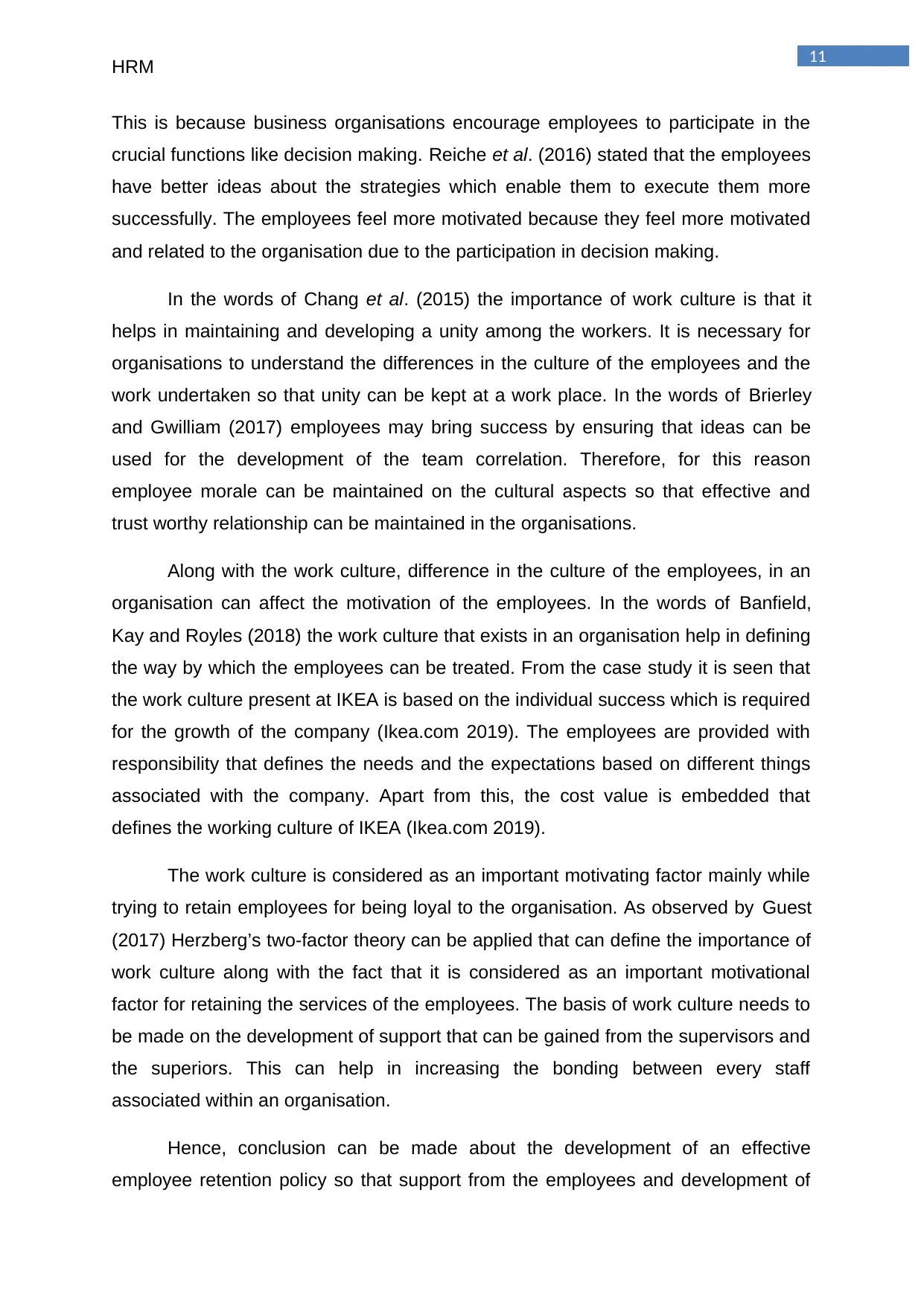
11
HRM
This is because business organisations encourage employees to participate in the
crucial functions like decision making. Reiche et al. (2016) stated that the employees
have better ideas about the strategies which enable them to execute them more
successfully. The employees feel more motivated because they feel more motivated
and related to the organisation due to the participation in decision making.
In the words of Chang et al. (2015) the importance of work culture is that it
helps in maintaining and developing a unity among the workers. It is necessary for
organisations to understand the differences in the culture of the employees and the
work undertaken so that unity can be kept at a work place. In the words of Brierley
and Gwilliam (2017) employees may bring success by ensuring that ideas can be
used for the development of the team correlation. Therefore, for this reason
employee morale can be maintained on the cultural aspects so that effective and
trust worthy relationship can be maintained in the organisations.
Along with the work culture, difference in the culture of the employees, in an
organisation can affect the motivation of the employees. In the words of Banfield,
Kay and Royles (2018) the work culture that exists in an organisation help in defining
the way by which the employees can be treated. From the case study it is seen that
the work culture present at IKEA is based on the individual success which is required
for the growth of the company (Ikea.com 2019). The employees are provided with
responsibility that defines the needs and the expectations based on different things
associated with the company. Apart from this, the cost value is embedded that
defines the working culture of IKEA (Ikea.com 2019).
The work culture is considered as an important motivating factor mainly while
trying to retain employees for being loyal to the organisation. As observed by Guest
(2017) Herzberg’s two-factor theory can be applied that can define the importance of
work culture along with the fact that it is considered as an important motivational
factor for retaining the services of the employees. The basis of work culture needs to
be made on the development of support that can be gained from the supervisors and
the superiors. This can help in increasing the bonding between every staff
associated within an organisation.
Hence, conclusion can be made about the development of an effective
employee retention policy so that support from the employees and development of
HRM
This is because business organisations encourage employees to participate in the
crucial functions like decision making. Reiche et al. (2016) stated that the employees
have better ideas about the strategies which enable them to execute them more
successfully. The employees feel more motivated because they feel more motivated
and related to the organisation due to the participation in decision making.
In the words of Chang et al. (2015) the importance of work culture is that it
helps in maintaining and developing a unity among the workers. It is necessary for
organisations to understand the differences in the culture of the employees and the
work undertaken so that unity can be kept at a work place. In the words of Brierley
and Gwilliam (2017) employees may bring success by ensuring that ideas can be
used for the development of the team correlation. Therefore, for this reason
employee morale can be maintained on the cultural aspects so that effective and
trust worthy relationship can be maintained in the organisations.
Along with the work culture, difference in the culture of the employees, in an
organisation can affect the motivation of the employees. In the words of Banfield,
Kay and Royles (2018) the work culture that exists in an organisation help in defining
the way by which the employees can be treated. From the case study it is seen that
the work culture present at IKEA is based on the individual success which is required
for the growth of the company (Ikea.com 2019). The employees are provided with
responsibility that defines the needs and the expectations based on different things
associated with the company. Apart from this, the cost value is embedded that
defines the working culture of IKEA (Ikea.com 2019).
The work culture is considered as an important motivating factor mainly while
trying to retain employees for being loyal to the organisation. As observed by Guest
(2017) Herzberg’s two-factor theory can be applied that can define the importance of
work culture along with the fact that it is considered as an important motivational
factor for retaining the services of the employees. The basis of work culture needs to
be made on the development of support that can be gained from the supervisors and
the superiors. This can help in increasing the bonding between every staff
associated within an organisation.
Hence, conclusion can be made about the development of an effective
employee retention policy so that support from the employees and development of
⊘ This is a preview!⊘
Do you want full access?
Subscribe today to unlock all pages.

Trusted by 1+ million students worldwide
1 out of 26
Related Documents
Your All-in-One AI-Powered Toolkit for Academic Success.
+13062052269
info@desklib.com
Available 24*7 on WhatsApp / Email
![[object Object]](/_next/static/media/star-bottom.7253800d.svg)
Unlock your academic potential
Copyright © 2020–2025 A2Z Services. All Rights Reserved. Developed and managed by ZUCOL.



